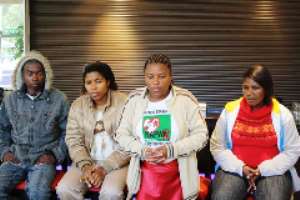
DARHOON MENGHWAR
Mothers2Mothers”, a Cape Town based international NGO providing education and health resources to pregnant women and mothers, reports that in South Africa some 28% of pregnant women are HIV positive. “These women have CD4 counts below 250,” an M2M doctor said, referring to the number of CD4 white blood cells that help fight infection and indicate resistance levels to HIV (the higher the count, the better). She added: “If HIV positive mothers come here in the first stage (of pregnancy) and get ante-retroviral drugs (ARV) then mostly their newborn will be HIV negative, but if pregnant women come in at 8 or 9 months then mostly the newborn will be HIV positive.”
A HIV positive mother, Nwabisa Telelo, who provides support to pregnant women at an M2M centre, said she was infected in 2001 during pregnancy and came to the centre for a test. “The doctor informed me about the virus - at that time I was mystified, I told only my husband not all the family, because they don't accept me, that I got ARV. Sadly, I gave birth to an HIV positive baby, my baby is here and I joined this centre and I'm providing support to mothers who are suffering from HIV. We are encouraging every mother to come for testing.”
Communications Manager Linda Codron said the M2M programme operates at 500 locations in South Africa, Kenya, Lesotho, Malawi, Rwanda, Swaziland and Zambia, where infected mothers provide support to mothers. “Our employees are about 1,400 HIV positive women, who conduct about 130,000 counseling sessions each month.”
Recent studies have shown that ARV treatment for mothers started during pregnancy and continued throughout the breastfeeding period significantly cut the rate of mother-to-child HIV transmission when compared with the standard short-course regimen. One study presented at the 5th International AIDS Society conference in Cape Town indicated a transmission rate below 1% resulting from ARV treatment during pregnancy and breastfeeding.
An Indian doctor, D.R. Jossy, who provides HIV/AIDS education for some 300,000 people in Rajasthan, said 86% of HIV infection in India was due to unsafe sex, 4.3% from Mother to Child transmission, 2.5% is syringe and poor blood screening and in 6% of cases the cause was not clear.
Dr. Laura Guay, from the Elizabeth Glaser Pediatric AIDS Foundation, listed the three ways in which mother-to-child HIV transmission can occur:
· 1. In the womb. Transmission seldom occurs this way as the baby is protected in a bag containing amniotic fluid and the mother's blood and baby's blood never come into direct contact.
· 2. During labour and delivery. Between 60% and 85% are infected in this way. The risk of infection increases as soon as the waters break and when the afterbirth comes away from the womb.
· 3. Breastfeeding. This, she said, accounts for about 15% of mother-to-child transmission cases.
World Health Organisation guidelines recommend exclusive breastfeeding for HIV-infected women for the first six months unless replacement feeding is acceptable, feasible, affordable, sustainable and safe for them and their infants before that time.




 There’s nothing you can do for us; just give us electricity to save our collapsi...
There’s nothing you can do for us; just give us electricity to save our collapsi...
 Ghanaian media failing in watchdog duties — Sulemana Braimah
Ghanaian media failing in watchdog duties — Sulemana Braimah
 On any scale, Mahama can't match Bawumia — NPP Youth Organiser
On any scale, Mahama can't match Bawumia — NPP Youth Organiser
 Never tag me as an NPP pastor; I'm 'pained' the 'Akyem Mafia' are still in charg...
Never tag me as an NPP pastor; I'm 'pained' the 'Akyem Mafia' are still in charg...
 Your refusal to dedicate a project to Atta Mills means you never loved him — Kok...
Your refusal to dedicate a project to Atta Mills means you never loved him — Kok...
 2024 elections: I'm competent, not just a dreamer; vote for me — Alan
2024 elections: I'm competent, not just a dreamer; vote for me — Alan
 2024 elections: Forget NPP, NDC; I've the Holy Spirit backing me and nothing wil...
2024 elections: Forget NPP, NDC; I've the Holy Spirit backing me and nothing wil...
 2024 elections: We've no trust in judiciary; we'll ensure ballots are well secur...
2024 elections: We've no trust in judiciary; we'll ensure ballots are well secur...
 Performance tracker: Fire MCEs, DCEs who document Mahama's projects; they're not...
Performance tracker: Fire MCEs, DCEs who document Mahama's projects; they're not...
 Train crash: Railway ministry shares footage of incident
Train crash: Railway ministry shares footage of incident
